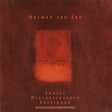Herman van San
Herman Van San was born on 19 March 1929 in Mechelen and died in the same city on 26 October 1975. He broke off his studies in musicology in order to study music theory and piano with G. Minet at the Royal Conservatory in Brussels. At the end of the 1940s he wrote an essay entitled De Nieuwe Muziek for the avant-garde magazine Tijd en Mens. Several years later (1951), Van San and R.C. Van de Kerckhove set up De Derde Ruiter which, as its subtitle indicated, was a Neo-Expressionist magazine. In various essays, mostly in foreign publications (including the Gravesaner Blätter, Ordini, and Interface), Van San set out his points of view, which were based on a Neo-Positivist position. In 1953 he undertook studies in philosophy and mathematics at the Université Libre de Bruxelles. A year later the sequel to his essay De Nieuwe Muziek appeared in Tijd en Mens, dealing with the state of serial composition at that time. After completing his philosophy degree, he studied physics, chemistry, biology and finally zoology and psychology, with the aim of positioning music – in a Neo-Positive sense – on a more formal foundation as a branch of the sciences. Van San worked out his theories implied by his notions of “mathematical electronic music” in the Cologne studios (the 1956/57 Opus Electronicum Mathematicum Geometrical patterns was realised in 1958 with Gottfried Michael Koenig in the WDR studio), in Gravesano (with Hermann Scherchen and Iannis Xenakis), in Brussels (studio Apelac) and ultimately in Ghent (at the Institute for Psychoacoustics and Electronic Music (IPEM), with Herman Sabbe). In many cases, however, Van San’s ideas often proved too much for the analogue techniques of music production then avaibable in the studio. Besides a performance of his opus 5 (1953/1954) Sectionen/Sneden at the Darmstädter Ferienkurse für Neue Musik, conducted by Bruno Maderna, Van San never found an opportunity to garner public attention, as his instrumental compositions often proved too difficult to perform and his electronic-mathematical designs impossible to realise with the existing equipment. It was only after his death in 1975, with the complete digitalisation of the electronic production process, that many of his ideas from the 1950s would be realised. Many of his compositions have been lost or destroyed.
Release
Contemporary composers
In 2020, Flanders Arts Institute made an overview of contemporary composers in Flanders.
Flanders Arts Institute
Expertise centre for performing arts, music and visual arts.


